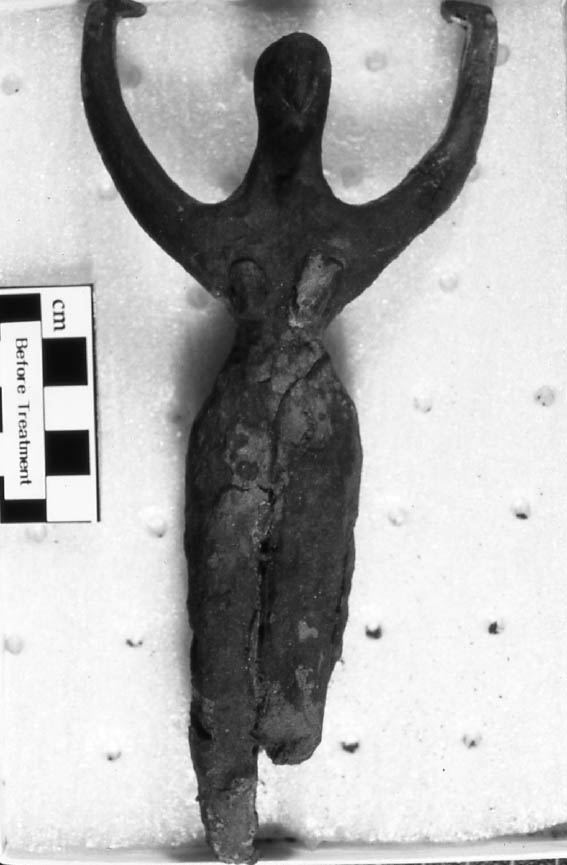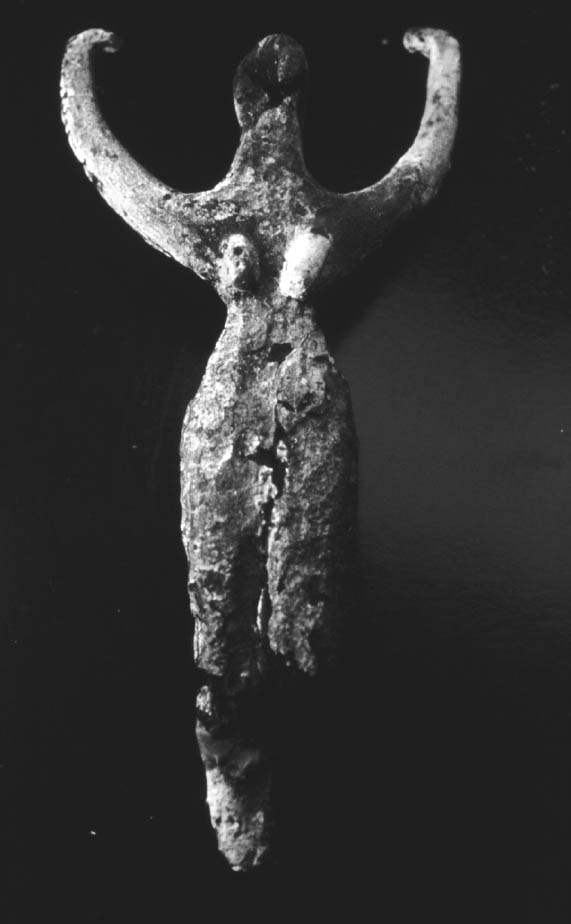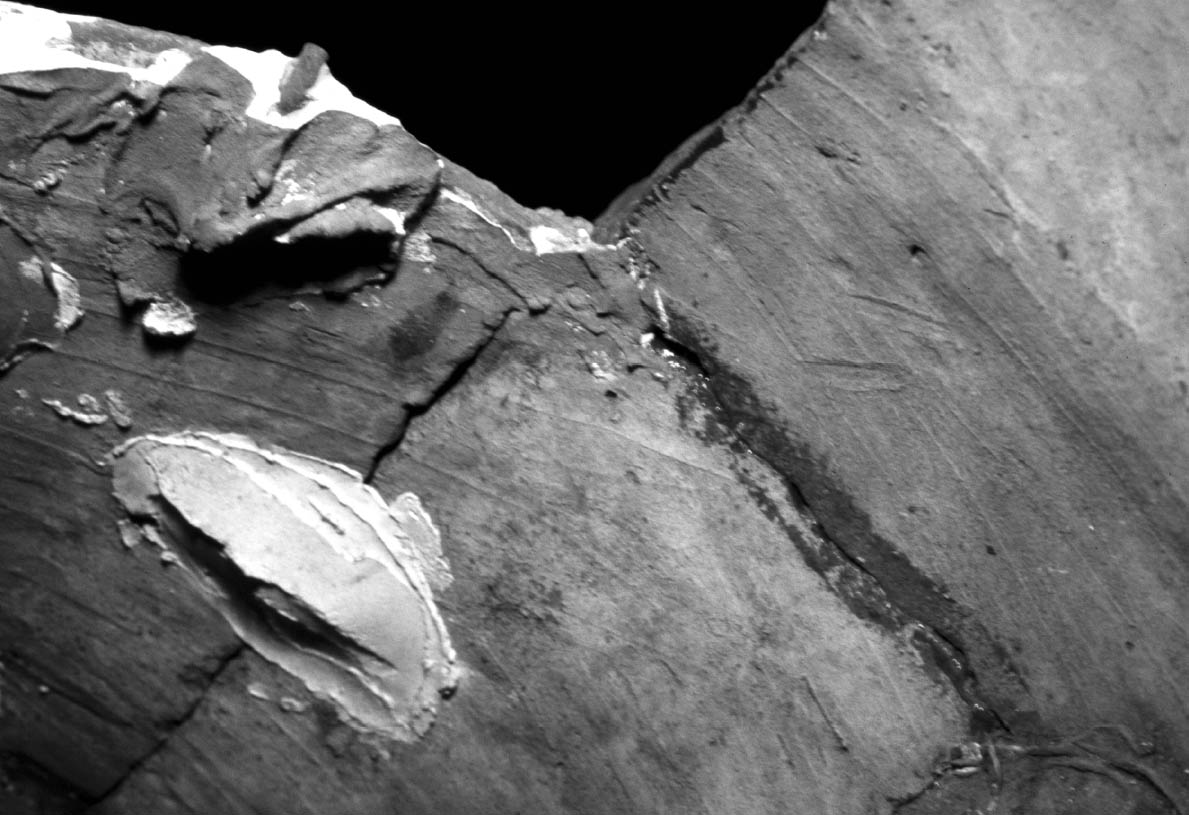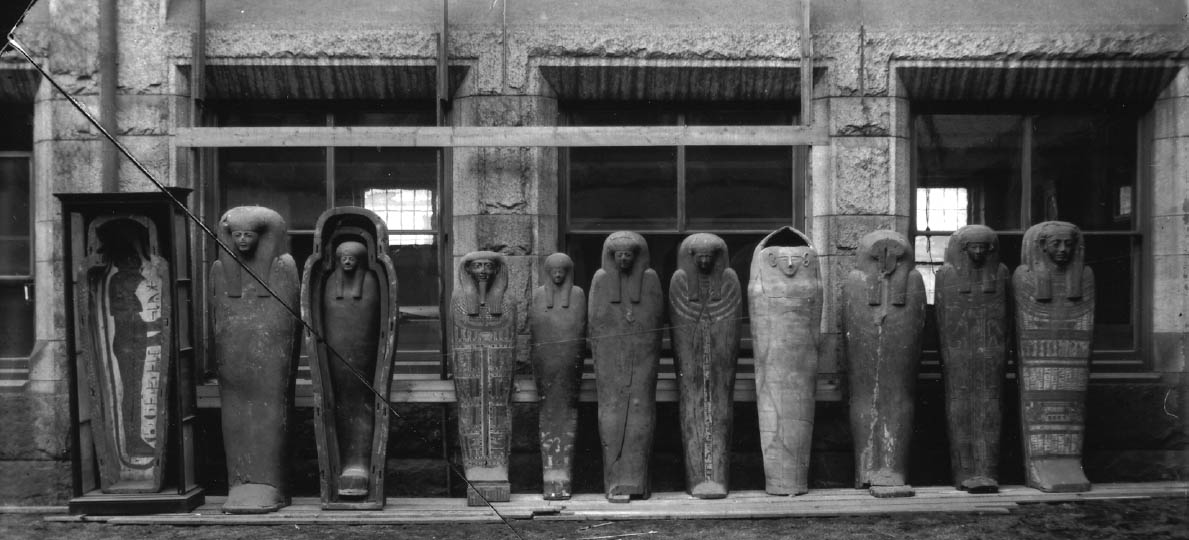THE ANCIENT EGYPTIAN COLLECTION AT THE MUSEUM OF FINE ARTS, BOSTON. PART 2, A REVIEW OF FORMER TREATMENTS AT THE MFA AND THEIR CONSEQUENCESSUSANNE G�NSICKE, PAMELA HATCHFIELD, ABIGAIL HYKIN, MARIE SVOBODA, & C. MEI-AN TSU
5 CERAMICS, FAIENCE, AND GLASSDocumentation of early treatment procedures at the MFA is scarce for ceramics, faience, and glass objects, possibly in part because these categories of artifacts were not as valued as the more “precious” objects made from metals, stone, or wood. Although records improved considerably after about 1970, they often do not include much detail on the nature of earlier restoration materials for objects that were being retreated or the specific problems that had developed as a result of earlier treatments. Statements that, for example, old unsightly repairs were reversed with water narrow down the possibilities of what materials might have been used in earlier treatments. More informative are rare notations of how the adhesive smelled when wetted. Almost all reviewed files for ceramics and faience involve the re-treatment of previously treated artifacts. In most cases the reasons for the re-treatment of ceramics and faience given in object files were active salts, adhesive failure, embrittlement and pulling up of ceramic, darkening, and staining. In many instances where shellac, PVAC emulsion, or the more unusual sealing wax repairs were used, complete reversal was nearly impossible. In these situations another adhesive, typically Paraloid B-72, is now introduced into the breaks for reinforcement. Up to this point in time, only a fraction of the ceramic, faience, and glass artifacts have been treated in any manner since arriving at the MFA, and future examinations will considerably increase our knowledge at least about field treatments that may have been carried out on those artifacts. 5.1 DESALINATIONGroups of objects that were excavated from the same trench usually exhibit similar states of preservation today, probably related mainly to the salt content of their burial environment. The recognized dangers of salts led to the desalination treatments that appear to have been common in the field, and treatments were required at the MFA also. In 1928 Dunham wrote to George A. Reisner that ceramics required salt extraction upon their arrival to the MFA and that he performed the treatments himself (Dunham 1928). Desalination campaigns, in some cases more than one on the same object, continue up to the present. Efflorescence has been the result of fluctuating relative humidity in storage or display environments or a consequence of conditions during travel for loans. The salt problem for some of the MFA Egyptian ceramics may have been aggravated or even made worse by the 1920 fire on board a steamer bound for Boston from Port Said, Egypt. Crates that had been soaked in seawater were not opened for months afterward. An example of a piece that has suffered from salts is a Predynastic terracotta figurine (MFA 04.1803; fig. 9; D'Auria et al. 1988), part of an excavated group purchased for the museum in 1904. The earliest documentation noted its unstable condition, a result of salt efflorescence in addition to having been broken and repaired. The surface of this artifact has a dark saturated “skin” from a previous consolidation treatment. However, just below the surface, where salt efflorescence has caused delamination of the consolidated surface layer, the interior is powdery and light in color. Thicker areas of locally applied adhesives are also visible: one is opaque and white, another dark and resinous. The multiple treatments, for which there are no records, were presumably performed to prevent the salt activity from completely destroying the artifact. Desalination was apparently never attempted, possibly because of the object's fragility.
5.2 CLEANINGA fairly standard treatment for ceramic and faience objects was washing in Calgon and immersion in acid solutions, such as hydrochloric acid, to remove lime deposits. Documentation indicates that artifacts were carefully washed after these procedures and that silver nitrate tests were performed on the wash water to determine when all traces of chlorides had been removed. No adverse effects from these treatments have been noted. 5.3 CONSOLIDATION AND REPAIRSA survey of treatment records indicates that shellac was the adhesive of choice until 1975; pearl glue and Alvar were mentioned by senior staff as further choices. Other adhesives listed in earlier records include fish glue, cellulose nitrate, and Dekadhese (DEK). Elmer's Glue-All was used primarily in the 1970s and early 1980s; generally PVAC resins were used extensively until the mid-1980s. Paraloid B-72 became the adhesive of choice from the late 1980s on and remains the most commonly used adhesive. Beadwork reconstruction continues to be performed today at the MFA. Restringing is based on the research conducted on preserved fragments, field notes, photographs, drawings, and/or similar examples in other collections. The information obtained from this investigation, in addition to studying the accurately restrung objects by Mary Reisner, has enabled MFA staff to restring beadwork objects using techniques similar to those of the ancient Egyptians. Ultraviolet examination of the Predynastic figurine, previously mentioned, showed three different adhesives on its surface (fig. 10; see page 245 for color image). Analysis of samples indicates that the entire object was first coated with a protein-containing glue. This treatment darkened the surface and apparently did little to consolidate the flaking terracotta due to its poor penetration. The thin surface “skin” that resulted from this treatment is peeling off in layers due to continued salt activity. Shellac, identified in isolated areas, may have been used to touch up holes made for samples taken for thermoluminescence dating. Another adhesive was mysteriously applied to random parts of the figurine, such as the proper left arm, breast, and proper right foot. This thickly applied material was identified as a mixture of sucrose (from cane sugar or honey), lactose (from a milk product), oils or fats (which could also be from a milk product), and a hydrocarbon wax, paraffin. Protein was also detected in this sample but may be contamination from the earlier consolidation campaign. Such complex adhesives were not uncommon during the midto late 19th century, and recipes appear in handbooks that would have been readily available at the time (Fishman 1986). A large ceramic artifact that underwent significant re-treatment is a coffin from Naukratis (Tell el-Yahudiya), dated to ca.1292–1075 B.C., that was excavated in 1888 (MFA 88.1041). The coffin was found
5.4 FILLS AND INPAINTINGThe fill composition most commonly noted in earlier object files consisted of a mixture of plaster and protein glue. Elmer's Glue-All replaced the latter in the 1970s. There are recipes for a “compo-like” fill material in Young's papers, but such a substance has yet to be identified on ceramic or faience artifacts. Inpainting over plaster fills using dry pigments and shellac was the preferred method from the 1950s until the 1980s. A faience hippopotamus statuette (MFA 51.8) from the Middle Kingdom was featured in an article in the MFA Bulletin in December 1951. The article
Not all re-treatments are successful or straightforward, and the course to be followed is not always clear. In the case of the Predynastic figurine, it is apparent that the salt problem requires addressing: however, its current fragile state may not permit any further action. Additional consolidation treatment may be inhibited by the presence of earlier treatment materials and could further compromise the condition of the object in the long term. With an understanding of the chemical properties of consolidation materials available today and their potential interactions with materials used in the past, treatment decisions can be made that will pose less risk to the artifacts if they are re-treated in the future. |



